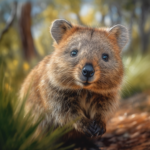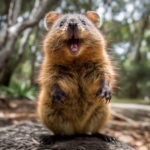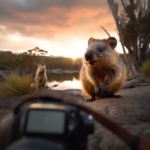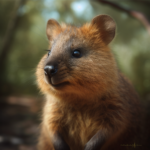The quokka, a small marsupial native to Western Australia, has gained quite a reputation for its adorable and seemingly smiling face. These charming creatures have captured the hearts of many, with their friendly and approachable demeanor. But do quokkas really smile? In this article, we will delve into the fascinating world of quokkas and explore the truth behind their famous grins. We will uncover the reasons behind their seemingly happy expressions and shed light on the unique behaviors and characteristics that make quokkas so special. So, let’s embark on this delightful journey and discover the secrets behind the quokka smile.
Key Takeaways
- Quokkas are small marsupials native to Western Australia.
- Quokkas have a unique smiling expression, which has earned them the title of “the world’s happiest animal.”
- The quokka smile is actually a natural facial expression, not a deliberate action.
- Quokkas are known for their friendly and curious nature, making them popular among tourists.
- It is important to respect and protect quokkas and their habitat to ensure their survival.
The Quokka: An Overview
A. Brief Description of Quokkas
Quokkas are small marsupials native to Western Australia. They belong to the macropod family, which also includes kangaroos and wallabies. These adorable creatures are known for their friendly nature and their unique facial expression that appears to be a smile. Quokkas have become famous for their photogenic appearance and have earned the title of “the world’s happiest animal.”
Quokkas are about the size of a domestic cat, with an average height of 16 inches and a weight of 6.6 to 11 pounds. They have a stocky build, short limbs, and a round face. Their fur is coarse and varies in color from brown to gray, with lighter shades on their undersides. Quokkas have a pouch on their belly, similar to other marsupials, where they carry and nurse their young.
B. Quokka Habitat and Lifestyle
Quokkas are primarily found on Rottnest Island, just off the coast of Perth, Western Australia. They are also present on a few other islands in the region, including Bald Island and Garden Island. These islands provide a suitable habitat for quokkas, as they offer a diverse range of vegetation and are free from predators.
Quokkas are herbivores, and their diet mainly consists of grasses, leaves, bark, and fruits. They are well-adapted to their environment and can survive on limited water sources. Quokkas have a unique ability to extract water from the vegetation they consume, allowing them to thrive in the dry climate of Western Australia.
In terms of behavior, quokkas are known for their social nature. They are generally non-aggressive and live in small family groups. Quokkas are active during the day and spend their time foraging for food and socializing with other members of their group. They have a curious and friendly demeanor, often approaching humans without fear.
Quokkas have gained popularity among tourists and photographers due to their photogenic appearance and friendly behavior. However, it is important to remember that they are wild animals and should be treated with respect. Feeding or touching quokkas is prohibited to ensure their well-being and preserve their natural behavior.
In conclusion, quokkas are fascinating creatures with their unique smile-like facial expression and friendly nature. They have adapted to their island habitat and play an important role in the ecosystem. The conservation efforts in Western Australia have helped protect the quokka population and ensure their survival for future generations to enjoy. So, if you ever have the chance to visit Rottnest Island or encounter a quokka in the wild, remember to appreciate their beauty from a respectful distance.
Unraveling the Quokka Smile

A. Do Quokkas Actually Smile?
Quokkas, the small marsupials native to Western Australia, have gained quite a reputation for their adorable smiles. But do they actually smile? The answer may surprise you.
While it may seem like quokkas are grinning from ear to ear, their facial expressions are not indicative of happiness or joy in the same way that humans smile. Quokkas have a unique facial structure that gives them a perpetually cheerful appearance. Their mouths naturally curve upward, creating the illusion of a smile.
B. Why Do Quokkas Appear to Smile So Much?
The reason behind the quokka’s seemingly constant smile lies in their facial anatomy. Quokkas have a short snout and a rounded face, which, combined with their upward-curving mouth, gives them a naturally cheerful expression. This unique facial structure has earned them the nickname “the happiest animal on Earth.”
Additionally, quokkas have large, round eyes that further contribute to their friendly appearance. Their eyes are often bright and alert, adding to their overall charm. When combined with their small stature and fluffy appearance, it’s no wonder that quokkas have become internet sensations and popular subjects for wildlife photography.
C. The Science Behind the Quokka Smile
The quokka smile is not just a result of facial structure; there is also a scientific explanation behind it. Research suggests that the upward curve of the quokka’s mouth is an adaptation that allows them to communicate their intentions to other members of their social group.
Quokkas are highly social animals and live in close-knit communities. Their perceived smile may serve as a form of non-verbal communication, signaling friendliness and reducing aggression within the group. By displaying a relaxed and approachable expression, quokkas are able to maintain harmonious relationships with their fellow quokkas.
It’s important to note that while quokkas may appear friendly and approachable, they are still wild animals and should be treated with respect. It is illegal to touch or feed quokkas in the wild, as this can disrupt their natural behavior and diet.
In conclusion, while quokkas may not smile in the same way that humans do, their unique facial structure and friendly appearance have captured the hearts of people around the world. The quokka smile is a testament to their social nature and serves as a reminder of the beauty and diversity of the animal kingdom. So, next time you come across a quokka picture, remember to appreciate their adorable smile while respecting their natural habitat.
Are Quokkas Really Happy?
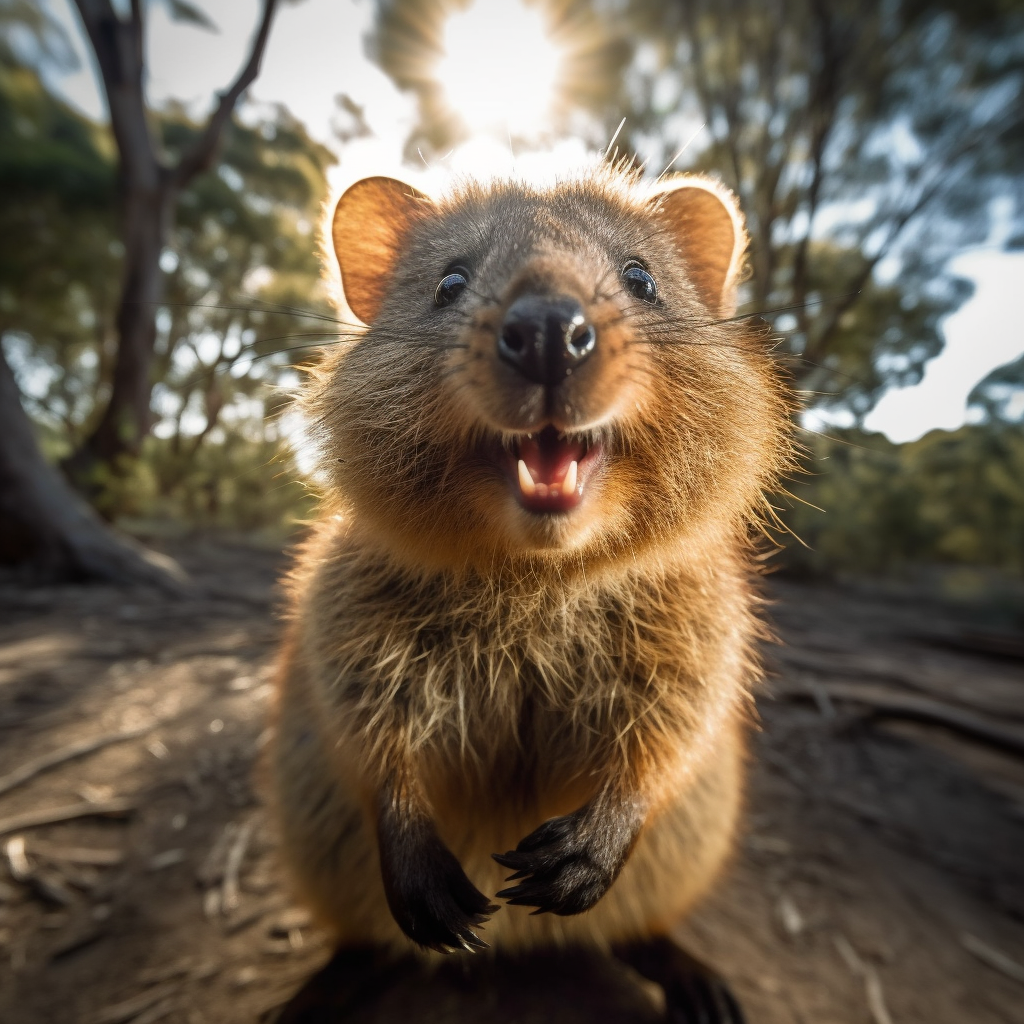
A. Understanding Quokka Behavior
Quokkas are small marsupials native to Western Australia, specifically found on Rottnest Island and a few other locations. These adorable creatures have gained significant attention due to their friendly nature and their seemingly smiling faces. However, it is important to understand their behavior before jumping to conclusions about their emotions.
Quokkas are primarily herbivorous and spend most of their time foraging for food. They are nocturnal animals, meaning they are most active during the night. During the day, they rest in shaded areas to avoid the heat. Quokkas are social animals and live in small family groups, which can consist of up to 150 individuals. They communicate with each other through various vocalizations and body language.
B. Interpreting Quokka Emotions: Is it Happiness?
The quokka‘s unique facial expression, often referred to as a smile, has led many people to believe that they are the happiest animals on the planet. However, it is crucial to remember that interpreting animal emotions solely based on facial expressions can be misleading.
While the quokka’s mouth does turn upward naturally, resembling a smile, it does not necessarily indicate happiness. It is important to consider other factors such as body language, vocalizations, and overall behavior when trying to understand an animal’s emotional state.
C. The Misconception of the Quokka Smile
The misconception of the quokka smile stems from the human tendency to anthropomorphize animals, attributing human emotions and characteristics to them. The quokka‘s unique facial structure, with a short snout and rounded cheeks, contributes to its seemingly smiling appearance.
In reality, the upward curve of the quokka’s mouth is a natural feature that helps them chew their food efficiently. It is not a deliberate expression of happiness or joy. Quokkas may exhibit this facial expression even when they are feeling stressed, threatened, or simply at rest.
It is essential to appreciate quokkas for their fascinating characteristics and their friendly nature towards humans. However, it is equally important to avoid projecting our own emotions onto them and to respect their natural behavior and habitat.
In conclusion, while the quokka’s smile may be adorable and captivating, it is crucial to understand that it does not necessarily indicate happiness. By considering their behavior, communication, and overall well-being, we can gain a better understanding of these fascinating creatures and appreciate them for who they truly are.
Why Quokkas are Considered the Happiest Animals in the World
A. The Role of Social Media in Quokka’s Happy Image
In recent years, the quokka, a small marsupial native to Western Australia, has gained significant attention and popularity on social media platforms. With their adorable smile and friendly nature, quokkas have become internet sensations, often referred to as the “happiest animals in the world.” But what is it about these creatures that make them so endearing and why do they appear to be constantly smiling?
One of the main reasons behind the quokka’s happy image is the power of social media. Platforms like Instagram and Facebook have allowed people from all over the world to share cute and heartwarming pictures of quokkas. These photos often depict the quokkas with their characteristic smile, which has become synonymous with their friendly and approachable nature.
The widespread sharing of these images has created a positive perception of quokkas, leading to an increased interest in visiting their natural habitat. Tourists flock to places like Rottnest Island, where quokkas roam freely, in the hopes of capturing a selfie with these adorable creatures. This surge in tourism has not only boosted the local economy but also raised awareness about the importance of preserving the quokka’s natural habitat.
B. The Impact of Human Perception on Quokka’s Happiness Image
While social media has played a significant role in shaping the quokka’s happy image, it is important to understand that the perception of happiness is subjective and influenced by human interpretation. Quokkas, like any other animal, do not possess the same range of emotions as humans. However, their facial expressions and behavior can often be misinterpreted as a smile.
Quokkas have a unique trait where the corners of their mouths are naturally upturned, giving them a perpetually cheerful appearance. This physical characteristic, combined with their friendly and curious nature, contributes to the perception of a smile. When quokkas feel threatened or stressed, their facial expression may change, but their default appearance still gives the impression of happiness.
It is crucial to remember that quokkas are wild animals and should be treated with respect and caution. While they may appear friendly, it is important to maintain a safe distance and not disturb their natural behavior. Feeding or touching quokkas can disrupt their natural diet and social interactions, which can have negative consequences for their well-being.
In conclusion, the quokka’s happy image is a result of a combination of factors, including social media exposure and human perception. Their unique physical appearance, coupled with their friendly nature, has endeared them to people around the world. However, it is essential to approach quokkas with respect and ensure their natural habitat is protected for future generations to enjoy these adorable creatures.
The Quokka Smile: A Survival Mechanism?
A. The Link Between Quokka’s Smile and Survival
The quokka, a small marsupial native to Western Australia, has gained worldwide fame for its adorable smile. But is there more to this charming expression than meets the eye? Many researchers believe that the quokka’s smile serves a crucial purpose in its survival.
One theory suggests that the quokka’s smile is a form of communication. Like humans, animals use facial expressions to convey emotions and intentions. The quokka‘s smile may be a way for it to signal its friendly nature to other members of its species. By displaying a relaxed and content expression, the quokka can establish a sense of trust and cooperation within its social group.
Another possibility is that the quokka’s smile is an evolutionary adaptation. In the harsh and competitive environment of Western Australia, where resources can be scarce, it is essential for animals to form alliances and cooperate with one another. The quokka‘s smile may have evolved as a way to facilitate social bonding and reduce aggression among individuals. By appearing non-threatening and approachable, the quokka increases its chances of forming positive relationships with other quokkas.
B. How Quokka’s Smile Helps in Adapting to Their Environment
The quokka‘s smile also plays a role in its ability to adapt to its environment. Quokkas are primarily herbivorous, feeding on a variety of plants, leaves, and grasses. However, their diet can be limited in certain seasons or habitats. In such situations, the quokka’s friendly expression may help it attract the attention of humans or other animals passing by.
Quokkas have been known to approach humans in search of food, especially on Rottnest Island, where they have become accustomed to human presence. Their approachable demeanor and seemingly smiling face make them popular subjects for wildlife photography. Tourists and locals alike are drawn to the quokka’s adorable smile, leading to increased interaction and potential food opportunities for these marsupials.
Furthermore, the quokka’s smile may also serve as a defense mechanism. When faced with a potential threat, the quokka may display its teeth in a wide grin, which can be mistaken for a smile. This behavior may deter predators or other animals from attacking, as the quokka appears confident and unafraid. By using its smile as a form of intimidation, the quokka increases its chances of survival in the wild.
In conclusion, the quokka’s smile is not merely a cute facial expression but a vital tool for its survival. Whether it is used for communication, social bonding, attracting attention, or self-defense, the quokka’s smile serves a purpose in its unique lifestyle. Understanding the significance of the quokka’s smile sheds light on the fascinating world of animal expressions and the intricate ways in which they adapt to their environment. So, the next time you come across a quokka‘s adorable smile, remember that there is more to it than meets the eye.
How to Say ‘Quokka’
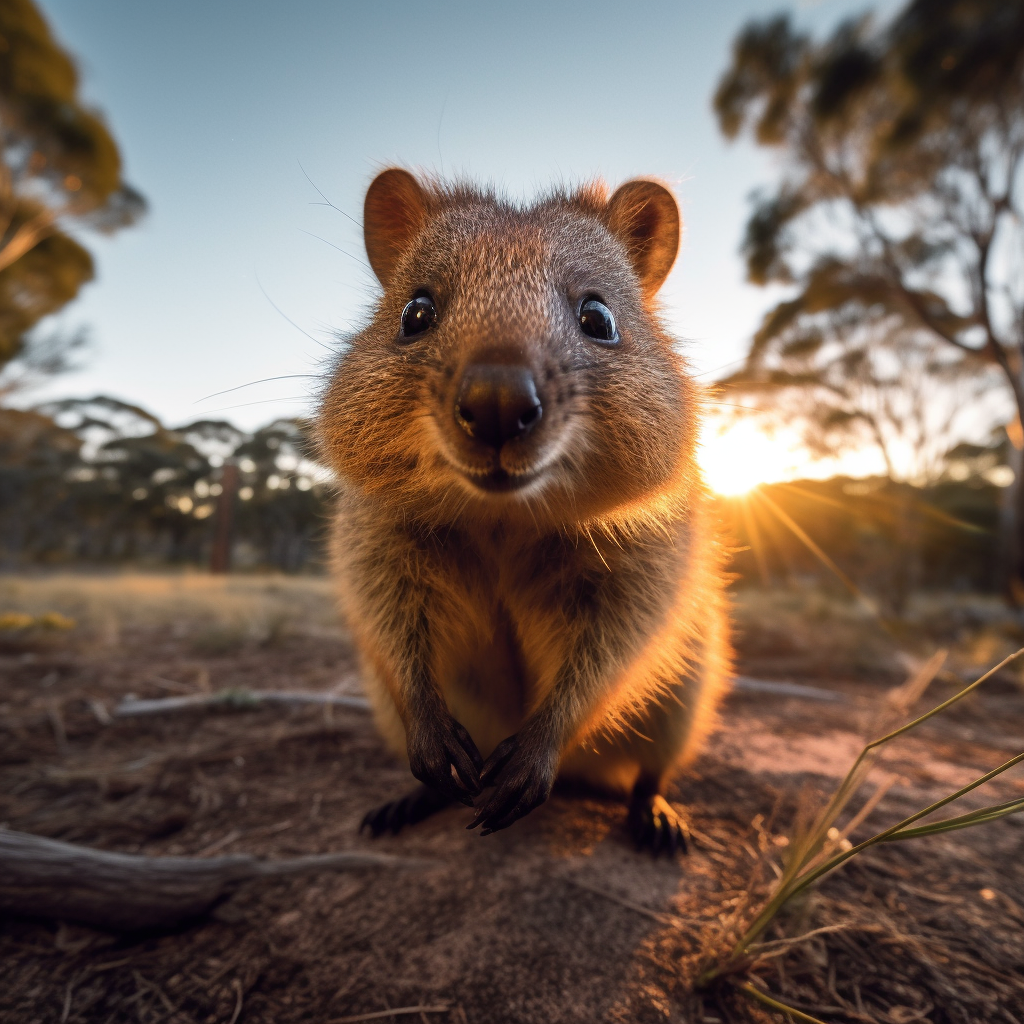
A. The Correct Pronunciation of Quokka
When it comes to pronouncing the word ‘quokka,’ you might be wondering if it’s a tricky tongue twister or a straightforward term. Well, fear not! The pronunciation of ‘quokka’ is actually quite simple. It is pronounced as “kwah-kuh.”
The first syllable, “kwah,” sounds like the word “quack” without the “ck” sound at the end. The second syllable, “kuh,” is pronounced like the letter “k” followed by the short “uh” sound.
To help you visualize the correct pronunciation, think of the word “quack” followed by the letter “a” at the end. When you put it all together, you get “kwah-kuh.”
B. The Origin of the Word ‘Quokka’
Now that you know how to say ‘quokka,’ let’s delve into the origin of this fascinating word. The term ‘quokka’ is derived from the Nyungar language, which is spoken by the Indigenous Noongar people of Western Australia.
In the Nyungar language, ‘quokka’ refers to the animal we commonly associate with the name. The Noongar people have a deep connection to the land and its wildlife, including the quokka. They have lived alongside these adorable creatures for thousands of years.
The word ‘quokka’ was first recorded by European explorers in the early 17th century. It is believed to have been adapted from the Noongar word ‘gwaga,’ which means ‘little animal.’ This is a fitting description for the quokka, as they are small marsupials that belong to the macropod family, which also includes kangaroos and wallabies.
The quokka‘s name not only reflects its diminutive size but also pays homage to the rich cultural heritage of the Noongar people. It serves as a reminder of the deep connection between humans and nature, which is an integral part of Indigenous Australian culture.
So, the next time you encounter the word ‘quokka,’ remember its origins in the Nyungar language and the significance it holds in the cultural tapestry of Australia. And now that you know how to pronounce it correctly, you can confidently share your knowledge about these adorable creatures with others.
The Influence of Quokka’s Smile on Human Emotions
A. How Quokka’s Smile Affects Human Perception
When it comes to adorable animals, the quokka is undoubtedly one of the most captivating creatures out there. Native to Western Australia, these small marsupials have gained fame for their friendly nature and, of course, their infectious smiles. But what is it about the quokka’s smile that makes it so appealing to humans?
First and foremost, it’s important to understand that the quokka’s smile is not a result of conscious emotion like it is in humans. Instead, it’s a facial expression that is naturally present due to the structure of their mouths. The shape of their lips and the positioning of their teeth create a permanent upturned appearance, giving them a perpetually happy and smiling expression.
This unique trait has a profound impact on human perception. When we see a quokka‘s smile, it triggers a positive emotional response within us. Our brains are wired to associate smiles with happiness, joy, and friendliness. Seeing a quokka‘s smile activates the same neural pathways that are activated when we see a human smile. It elicits feelings of warmth, affection, and a sense of connection.
B. The Positive Impact of Quokka’s Smile on Human Emotions
The quokka‘s smile has been known to have a remarkable effect on human emotions. Interacting with these adorable creatures, whether in person or through photographs, can instantly uplift our spirits and brighten our day. Here are a few ways in which the quokka’s smile positively impacts our emotions:
-
Boosts Happiness: The sight of a quokka‘s smile triggers the release of endorphins, the feel-good hormones in our brains. This surge of happiness can improve our mood and overall well-being.
-
Reduces Stress: Research has shown that looking at cute and smiling animals, like the quokka, can help reduce stress levels. The quokka‘s friendly expression and carefree demeanor have a calming effect on our minds.
-
Promotes Empathy: The quokka‘s smile evokes a sense of empathy within us. We are naturally drawn to their happiness and innocence, which can increase our capacity for compassion and understanding.
-
Enhances Social Connection: Sharing cute quokka pictures or stories with friends and family can foster a sense of togetherness. The quokka‘s smile becomes a topic of conversation and brings people closer, creating a positive social bond.
-
Inspires Positivity: The quokka‘s perpetual smile serves as a reminder to find joy in the simple things in life. Their carefree and contented nature can inspire us to adopt a more positive outlook and appreciate the beauty around us.
In conclusion, the quokka’s smile has a profound impact on human emotions. Its infectious and adorable expression triggers feelings of happiness, reduces stress, promotes empathy, enhances social connection, and inspires positivity. Whether encountered in person or through photographs, the quokka’s smile has the power to brighten our day and remind us of the simple joys in life. So next time you come across a quokka, take a moment to appreciate their unique and heartwarming smile. Conclusion
In conclusion, the quokka is a unique and fascinating marsupial that has captured the hearts of many with its adorable smile. While it may appear as if the quokka is smiling, it is important to remember that this expression is not necessarily indicative of the animal‘s emotions. The quokka‘s facial structure simply gives it a perpetually happy appearance. These small creatures are known for their friendly and curious nature, making them a popular attraction for tourists visiting Rottnest Island in Western Australia. However, it is crucial to respect their natural habitat and refrain from approaching or feeding them. Quokkas are a vulnerable species, and it is important to protect their population and preserve their unique characteristics for future generations to enjoy. So, next time you come across a photo of a quokka smiling, remember that it’s not just their smile that makes them special, but also their role in the ecosystem and the need to conserve their habitat.
Frequently Asked Questions
1. Are quokkas actually happy?
Quokkas are often perceived as being happy due to their facial expressions. However, these expressions are not necessarily indicative of their emotional state. They are a part of Quokka’s unique traits and characteristics that make them appear as if they’re smiling.
2. Why do quokkas smile so much?
Quokkas don’t actually smile. Their natural facial structure gives the appearance of a constant smile. This is a common misconception due to the anthropomorphizing of animal expressions.
3. Why is quokka the happiest animal in the world?
Quokkas have been dubbed the ‘happiest animal in the world’ due to their seemingly constant smile. However, it’s important to understand that this is just a part of their facial structure and not necessarily a reflection of their mood or happiness.
4. Do quokkas naturally smile?
Quokkas do not naturally smile in the way humans do. Their facial structure simply gives the appearance of a smile, which has contributed to their reputation as the ‘happiest animal in the world’.
5. Why are quokkas so happy?
It’s a misconception that quokkas are always happy. Their ‘smiling’ facial expression is simply a result of their facial structure. Their behavior and lifestyle, however, do show that they are generally non-aggressive and friendly creatures.
6. How do you pronounce ‘quokka’?
‘Quokka’ is pronounced as ‘Kwok-ka’.
7. Why are quokkas always smiling?
Quokkas aren’t actually always smiling. Their natural facial structure gives the appearance of a constant smile. This has led to the perception that they are always happy, but it’s important to remember that animal expressions don’t necessarily reflect their emotions as human expressions do.
8. What is the quokka’s lifestyle like in Australia?
Quokkas are native to small islands off the coast of Western Australia, in particular, Rottnest Island. They are nocturnal creatures and spend most of the day resting. They are also known for their friendly nature and lack of fear of humans, often approaching people without hesitation.
9. How can I capture cute quokka pictures?
Quokkas are quite friendly and approachable, making them a popular subject for wildlife photography. However, it’s important to respect their space and not disturb them in their natural habitat. Always follow local guidelines and regulations when photographing wildlife.
10. What is the social behavior of quokkas?
Quokkas are known for their friendly and sociable behavior. They live in large communities and are often seen interacting with each other. They are also known to approach humans without fear, contributing to their reputation as the ‘happiest animal in the world’.

